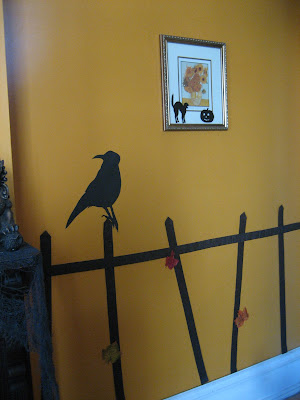Hallowe'en has it's roots in the Celtic harvest festival of Samhain and the Christian holiday, All Saint's Day. The Celtic festival of Samhain (the name is derived from Old Irish which means roughly "summer's end") celebrates the end of the 'lighter half' of the year and the beginning of the 'darker half'; also known as the Celtic New Year (The Celtic new year started on November 1). The ancient Celts believed that the border between this world and the Otherworld became thin during the time of Samhain, allowing spirits, both good and bad, to pass through. The family's ancestors were honored and invited home, while harmful spirits were warded off. It is believed that the wearing of costumes and masks, to disguise oneself as an 'evil spirit', was used to avoid harm. Samhain was also the time of year to take stock of food supplies, harvest crops and slaughter livestock for the coming winter.
Large bonfires also played a large part in the festivities.In Scotland and Wales, people still set blazing bonfires near their homes to keep the evil spirits from their doors. Inside, each family member drinks a special "brew" blended from cinnamon, nutmeg, Drambuie and the yolks of eggs, which is believed to ward off spirits that may have snuck past the blazes. In our local area, some people still carry out the family tradition of burning fires as late as midnight on Halloween.
The souling practice of commemorating the souls in purgatory with candle lanterns carved from turnips became adapted into the making of jack-o'-lanterns. In traditional Celtic Halloween festivals, large turnips were hollowed out, carved with faces, and placed in windows to ward off evil spirits.
The name, "Hallowe'en", is derived from All Hallow's Even, the night before All Hallow's Day.
All Saints Day is offically known as Solemnity of All Saints,and is also known All Hallows or Hallowmas. It is a solemnity celebrated on November 1 in Western Christianity, and on the first Sunday after Pentecost in Eastern Christianity, in honour of all the saints, known and unknown. Christian denominations celebrate Solemnity of All Saints' Day and the Feast of All Soul's Day because of the belief that there is a prayerful spiritual communion between those in a state of grace who have died that are either in purgatory or are in heaven, and the living. Those that have died that are with God watch over the living and the saints are held to intercede with God on the behalf of the living. On their part, the living pray to the saints and remember in intercessory prayers to God those that have died, particularly deceased family and friends. Trick-or-treating resembles the late medieval practice of souling, when poor folk would go door to door on Hallowmas (November 1), receiving food in return for prayers for the dead on All Souls Day (November 2).
And the last of my Hallowe'en decor to go up is my spooky fence:
I made the fence using black crepe paper streamers, and then drew the raven silhouette on plain paper to use as a template to cut out from black card stock. A few faux silk colored leaves are 'caught' in the rickety old fence.
I think Euphraxia approves.
A note on Witches: In Shakespeare's play, Macbeth, the Three Witches represent darkness, chaos, and conflict, while their role is as agents and witnesses. Their presence communicates treason and impending doom. During Shakespeare's day, witches were seen as worse than rebels, "the most notorious traytor and rebell that can be." They were not only political traitors, but spiritual traitors as well.
Much of the confusion that springs from them comes from their ability to straddle the play's borders between reality and the supernatural. They are so deeply entrenched in both worlds that it is unclear whether they control fate, or whether they are merely its agents. They defy logic, not being subject to the rules of the real world.The witches' lines in the first act: "Fair is foul, and foul is fair: Hover through the fog and filthy air" are often said to set the tone for the rest of the play by establishing a sense of confusion. Indeed, the play is filled with situations where evil is depicted as good, while good is rendered evil. The line "Double, double toil and trouble," (often sensationalized to a point that it loses meaning), communicates the witches' intent clearly: they seek only trouble for the mortals around them.
Thanks for stopping by!




2 comments:
I adore Euphraxia. And that crepe paper picket idea is great. It looks like one of those rub on stecils from Martha Stewart (that I am paranoid to put on my walls in case they don't come off easily).
BTW, I'm your newest follower although I thought I had been following you all along. I'm ditsy like that sometimes.
Dearest Katie,
Thanks again for a tremendously informative blog! You did do quite some extensive research and I appreciate you sharing this. It ought to be read by thousands as it is so important to know what this season is all about. Most people will have no inkling...
Have a wonderful Sunday and a great week ahead. Sunny greetings from Georgia/USA
MariettesBacktoBasics
Post a Comment